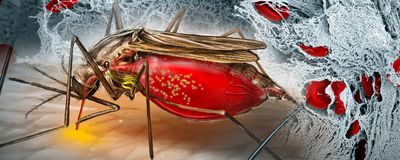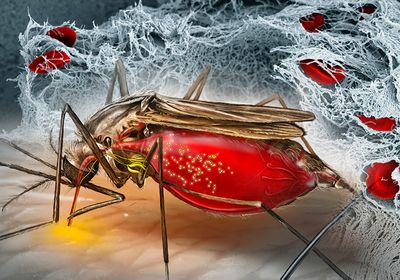ABOVE: Researchers found that a mosquito salivary protein degraded fibrin clots in the insect’s stomach, and this helped parasite transmission. Ryan Kissinger
Living on a diet of blood requires some specific adaptations, such as a way to keep the food source flowing. To prevent their meal from turning into an indigestible clot, mosquitoes evolved very useful spit. “The saliva of mosquitoes is like a pharmacy. It's a cocktail of drugs and protein that will regulate several biological processes,” said Joel Vega-Rodriguez, a parasitologist and vector entomologist at the National Institute of Allergy and Infectious Diseases. These salivary proteins include different factors that can impair normal host immune responses, stop platelet aggregation, or degrade fibrin, a major protein in blood clots.
However, when these insects take a bite, they can pick up more than just blood; they also transmit pathogens like the parasite Plasmodium falciparum, the causative agent of malaria. Previous studies demonstrated that mosquito salivary proteins also influence parasite transmission, but these mechanisms remain poorly studied.1,2
Vega-Rodriguez and his team wanted to explore how mosquito saliva dampened blood clotting within the insect and the role that this played in parasite transmission.
In a study published in Nature Communications, Vega-Rodriguez and his team demonstrated that a protein known to degrade fibrin in the skin also does so in the stomach of Anopheles gambiae, a mosquito that can carry malaria, where it also promotes parasite transmission.3 These findings could offer new disease mitigation strategies.
Blood clotting and the subsequent degradation of that clot is regulated by multiple proteins. One of these proteins, tissue-type plasminogen activator (tPA), activates an enzyme that breaks down fibrin. Since mosquitoes also manipulate the host blood clotting process, the team explored whether their saliva activates tPA. After collecting mosquito spit from the midgut, they performed size exclusion chromatography and mass spectrometry to isolate candidate proteins. When the team evaluated the molecules’ ability to activate tPA, one protein stood out: apyrase, an enzyme that converts adenosine triphosphate (ATP) and adenosine diphosphate (ADP) into adenosine monophosphate (AMP).4
Since ADP and AMP are involved in platelet activation, apyrase works as an anticoagulant by limiting the availability of these products.5,6 However, most studies explored its activity in the host’s skin to promote blood feeding.7 “Now we have to rethink about all those functions in the context of the midgut,” Vega-Rodriguez said.
Using immunohistochemistry (IHC), the team determined that mosquitoes’ stomachs contained more apyrase following a bloodmeal compared to before feeding. To study the protein’s effect on ingested blood, the researchers fed mosquitoes on mice before and after the animals were treated with a recombinant apyrase and then studied the contents of their guts. Additional apyrase increased the amount of fibrin byproducts in mosquito stomachs and decreased the amount of whole fibrin compared to samples taken prior to apyrase treatment. Additionally, they demonstrated by IHC that apyrase supplementation prior to insect feeding decreased platelet aggregation in mosquito stomachs to a greater extent than in insects with only endogenous apyrase levels in the bloodmeal.
Preventing blood coagulation is important for mosquito nutrition, but keeping blood soluble can aid Plasmodium parasites’ survival too. Male gametes from the bloodmeal that matured in the insect must traverse the stomach contents to find a female gamete, where they merge and develop into infectious cells called sporozoites.
Based on his team’s previous findings that Plasmodium hijacks host anticoagulant factors, including tPA, Vega-Rodriguez and his team explored the influence of mosquito apyrase on the parasite’s transmission.8 In one experiment, they let the mosquitoes feed from mice infected with Plasmodium berghei, which causes rodent malaria, before and after treatment with recombinant apyrase. They found that apyrase-treatment prior to mosquito feeding increased the number of developing parasites in the insect. However, when they immunized mice against apyrase and then infected them prior to the mosquitoes’ feast they observed a reduction in the parasite burden in mosquitos.
To further study the effects of apyrase on parasite transmission, the team studied parasite migration into the new animal host. They observed that parasites introduced into mice from infected mosquitoes migrated to the animals’ livers less efficiently in mice previously immunized against apyrase. The ability to block two forms of parasite transmission by targeting apyrase was one reason that the findings excited Vega-Rodriguez for its potential as a vaccine candidate, but also, he said “[Apyrase is] not parasite-related, it's mosquito protein, so it reduces the pressure for the parasite to develop any escape or any interventions that are targeting apyrase.”
Additionally, he explained that many other disease-carrying vectors ingest their own saliva. “Our findings not only apply for Anopheles and malaria; this could apply for Aedes and the viruses that it transmits. It could apply for the sandfly and the parasite that they transmit [that causes] Leishmania, [and] the kissing bugs and the trypanosome parasites. And you could continue with all the vectors that ingest blood, even ticks.”
Mary Ann McDowell, a vector biologist and parasitologist at the University of Notre Dame who was not involved in the study, thought targeting the apyrase in a vaccine was a novel approach compared to other candidates that researchers are considering for controlling parasite transmission. McDowell’s research team previously studied sand fly salivary proteins for their potential as vaccine candidates to prevent leishmaniasis, caused by Leishmania major.9
McDowell also liked the approach of studying transmission from the natural vector as opposed to artificial infection with needles. “We need to really understand the full biology of how the infection happens, because I think it can really change the outcome,” she said.
- Titus RG, Ribeiro JMC. The role of vector saliva in transmission of arthropod-borne disease. Parasitol Today. 1990;6(5):157-160.
- Schleicher TR, et al. A mosquito salivary gland protein partially inhibits Plasmodium sporozoite cell traversal and transmission. Nat Commun. 2018;9(1):2908.
- Pala ZR, et al. Mosquito salivary apyrase regulates blood meal hemostasis and facilitates malaria parasite transmission. Nat Commun. 2024;15(1):8194.
- Champagne DE, et al. The salivary gland-specific apyrase of the mosquito Aedes aegypti is a member of the 5’-nucleotidase family. Proc Natl Acad Sci USA. 1995;92(3):694-698.
- Gachet C, Cazenave JP. ADP induced blood platelet activation: A review. Nouv Rev Fr Hematol. 1991;33:347-358.
- Randriamboavonjy V, et al. AMPK α2 subunit is involved in platelet signaling, clot retraction, and thrombus stability. Blood. 2010;116(12):2134-2140.
- Fontaine A, et al. Implication of haematophagous arthropod salivary proteins in host-vector interactions. Parasit Vectors. 2011;4:187.
- Alves e Silva TL, et al. The fibrinolytic system enables the onset of Plasmodium infection in the mosquito vector and the mammalian host. Sci Adv. 2021;7(6):eabe3362.
- Flanley C, et al. Phlebotomus papatasi sand fly predicted salivary protein diversity and immune response potential based on in silico prediction in Egypt and Jordan populations. PLoS Negl Trop Dis. 2020;14(7):e0007489.




